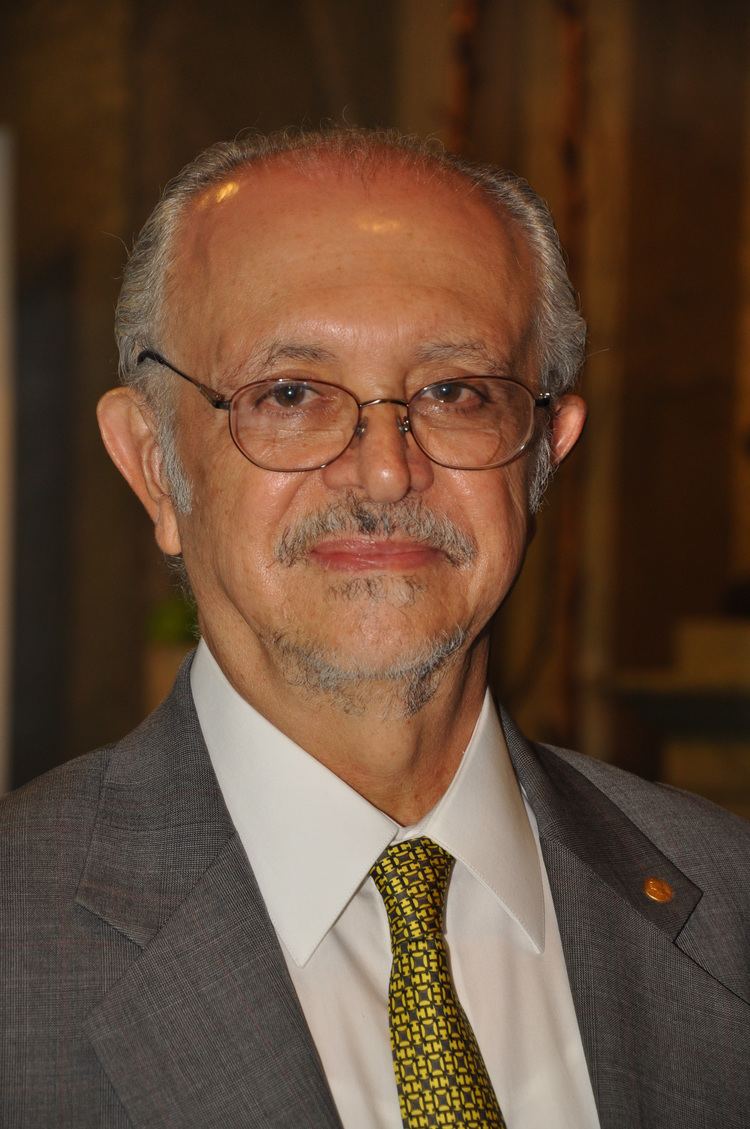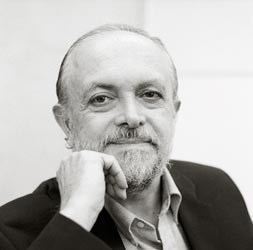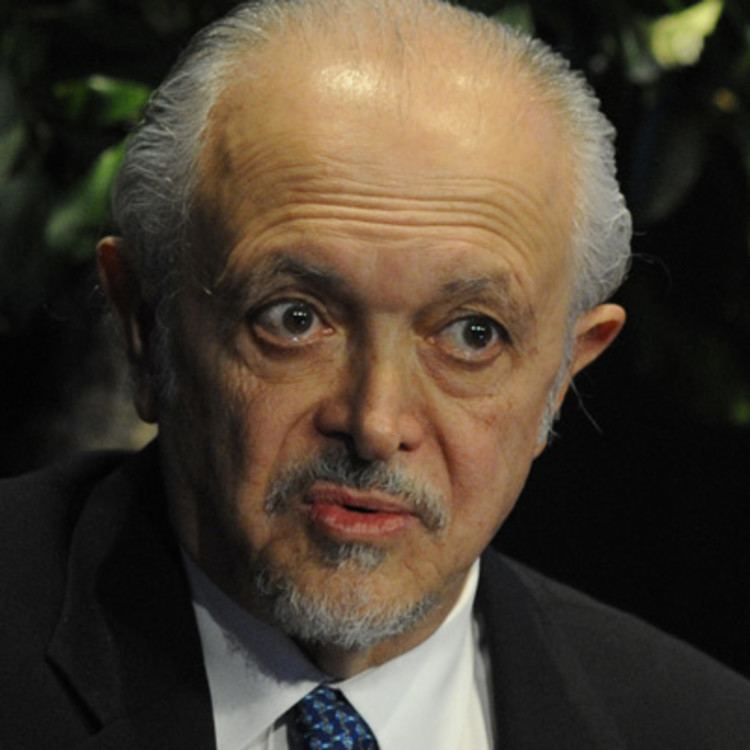Citizenship Mexican Children Felipe Molina Tan Role Chemist | Name Mario Molina Fields Chemistry | |
 | ||
Born March 19, 1943 (age 81)
Mexico City, Mexico ( 1943-03-19 ) Institutions University of California, San Diego
University of California, Irvine
Jet Propulsion Laboratory
Massachusetts Institute of Technology Alma mater National Autonomous University of Mexico
Albert-Ludwigs-Universitat Freiburg
University of California, Berkeley Known for Researched the threat of CFCs to the ozone layer in the stratosphere. Notable awards Tyler Prize for Environmental Achievement (1983)
Newcomb Cleveland Prize (1987)
NASA Exceptional Scientific Achievement Medal (1989),
Nobel Prize in Chemistry (1995)
UN Environment Programme Sasakawa Environment Prize (1999)
The 9th Annual Heinz Award in the Environment (2003),
The Volvo Environment Prize (2004).
Presidential Medal of Freedom (2013) Spouse Guadalupe Alvarez (m. 2006) Parents Leonor Henriquez de Molina, Roberto Molina Pasquel Education National Autonomous University of Mexico, Albert Ludwigs University of Freiburg, University of California, Berkeley Awards Nobel Prize in Chemistry, Tyler Prize for Environmental Achievement, NASA Exceptional Scientific Achievement Medal Similar People Frank Sherwood Rowland, Paul J Crutzen, Luis E Miramontes, Andres Manuel del Rio, Alfonso Garcia Robles | ||
Saturday conversation mario j molina
Mario José Molina-Pasquel Henríquez (born March 19, 1943) is a Mexican chemist reputed for his pivotal role in the discovery of the Antarctic ozone hole. In 2004 he became professor at the University of California, San Diego and the Center for Atmospheric Sciences at the Scripps Institution of Oceanography. He was a co-recipient of the 1995 Nobel Prize in Chemistry for his role in elucidating the threat to the Earth's ozone layer of chlorofluorocarbon gases (or CFCs), becoming the first Mexican-born citizen to ever receive a Nobel Prize in Chemistry. Molina is a climate policy adviser to President of Mexico, Enrique Peña Nieto.
Contents
- Saturday conversation mario j molina
- Ideas nobel laureate mario j molina
- Biography
- His discovery
- Honors
- Honorary degrees
- References

Ideas nobel laureate mario j molina
Biography

Molina is the son of Roberto Molina-Pasquel, a lawyer and judge who went on to serve as chief Ambassador to Ethiopia, Australia and the Philippines in 1923, and Leonor Henríquez. As a child he converted a bathroom into his own little laboratory, using toy microscopes and chemistry sets. He also looked up to his aunt Esther Molina, who was a chemist, and who helped him with his experiments.

After completing his basic studies in Mexico City and at the Institut auf dem Rosenberg in Switzerland he earned a bachelor's degree in chemical engineering at the National Autonomous University of Mexico (UNAM) in 1965. Two years later he earned his postgraduate degree at the Albert Ludwigs University of Freiburg, West Germany, and a Ph.D. in chemistry at the University of California, Berkeley in 1972. Molina married chemist Luisa Y. Tan in July 1973. They moved to Irvine, California that fall.

In 1974, as a postdoctoral researcher at University of California, Irvine, he and Rowland co-authored a paper in the journal Nature highlighting the threat of CFCs to the ozone layer in the stratosphere. At the time, CFCs were widely used as chemical propellants and refrigerants. Initial indifference from the academic community prompted the pair to hold a press conference at a meeting of the American Chemical Society in Atlantic City in September 1974, in which they called for a complete ban on further releases of CFCs into the atmosphere. Skepticism from scientists and commercial manufacturers persisted, however, and a consensus on the need for action only began to emerge in 1976 with the publication of a review of the science by the National Academy of Sciences. This led to moves towards the worldwide elimination of CFCs from aerosol cans and refrigerators, and it is for this work that Molina later shared the Nobel Prize in Chemistry.

Between 1974 and 2004 he variously held research and teaching posts at University of California, Irvine, the Jet Propulsion Laboratory at Caltech and the Massachusetts Institute of Technology (MIT), where he held a joint appointment in the Department of Earth Atmospheric and Planetary Sciences and the Department of Chemistry. On July 1, 2004 Molina joined the Department of Chemistry and Biochemistry at University of California, San Diego and the Center for Atmospheric Sciences at the Scripps Institution of Oceanography.

Molina is a member of the Pontifical Academy of Science, the National Academy of Sciences, the Institute of Medicine and The National College of Mexico. He serves on the boards of several environmental organizations and also sits on a number of scientific committees including the U.S. President's Committee of Advisors in Science and Technology, the Institutional Policy Committee, the Committee on Global Security and Sustainability of the John D. and Catherine T. MacArthur Foundation and the Mario Molina Center. He also served on the board of trustees for Science Service, now known as Society for Science & the Public, from 1999-2006. He has also received more than thirty honorary degrees and Asteroid 9680 Molina is named in his honor. In 2003 he was one of twenty-two Nobel Laureates who signed the Humanist Manifesto.

Molina and his first wife, Luisa Tan Molina, divorced, and he married his second wife, Guadalupe Álvarez, in February 2006. His only son works as a physician in Boston. Molina was named by U.S. President Barack Obama to form a transition team on environmental issues.
His discovery
Mario Molina joined the lab of Professor F. Sherwood Rowland in 1973 as a postdoctoral fellow. Here, Molina continued Rowland's pioneering research into "hot atom" chemistry, which is the study of chemical properties of atoms with, and only with, excess translational energy owing to radioactive processes. This study soon led to research into chlorofluorocarbons (CFCs), which had been accumulating in the atmosphere. Rowland and Molina had investigated other compounds similar to CFCs before, and together they developed the CFC ozone depletion theory. Molina tried to figure out how CFCs might be destroyed in the lower atmosphere, but nothing seemed to work. He and Rowland knew that if CFCs released into the atmosphere do not decay by other processes, they continually rise to higher altitudes until they are destroyed by solar radiation. They discovered that chlorine atoms, produced by the decomposition of CFCs, catalytically destroy ozone. Rowland and Molina published their findings in Nature on June 28, 1974, and also made an effort to announce their findings outside of the scientific community, informing policy makers and the news media of their work. Attesting to the continuing importance of their discovery, to this day there are still laws that protect the ozone layer by regulating the use of CFCs.
Honors
Mario Molina received several awards and honors, sharing the 1995 Nobel Prize in chemistry with Paul J. Crutzen and F. Sherwood Rowland for their discovery of the role of CFCs in ozone depletion.
He is a fellow of the American Association for the Advancement of Science, the U.S. National Academy of Science and the Mexican Academy of Sciences.
He also won the 1987 Esselen Award of the Northeast section of the American Chemical Society,
In 1988 he won the Newcomb-Cleveland from the American Association for the Advancement of Science.
A few other awards he won were the 1989 NASA Medal for Exceptional Scientific Advancement and the 1989 United Nations Environmental Programme Global 500 Award.
In 1990, the Pew Charitable Trusts Scholars Program in Conservation and the Environment honored him as one of the ten environmental scientists and awarded him a 150,000 dollar grant.
He received the 1998 Willard Gibbs Award from the Chicago Section of the American Chemical Society and the 1998 American Chemical Society Prize for Creative Advances in Environment Technology and Science
On August 8, 2013, President Barack Obama announced Molina as a recipient of the Presidential Medal of Freedom citing in the press release:
Mario Molina is a visionary chemist and environmental scientist. Born in Mexico, Dr. Molina came to America to pursue his graduate degree. He later earned the Nobel Prize in Chemistry for discovering how chlorofluorocarbons deplete the ozone layer. Dr. Molina is a professor at the University of California, San Diego; Director of the Mario Molina Center for Energy and Environment; and a member of the President’s Council of Advisors on Science and Technology.